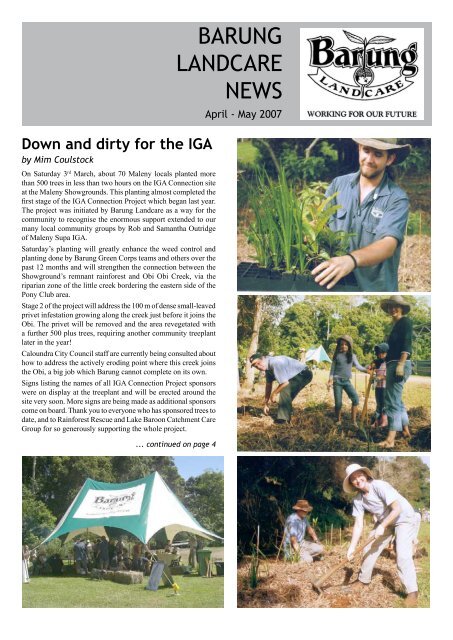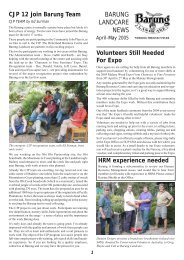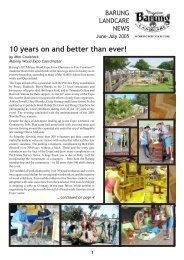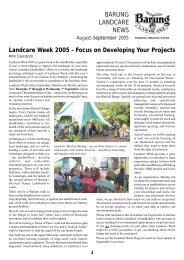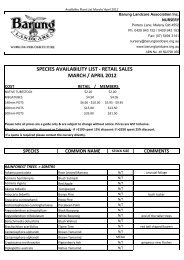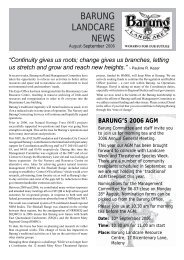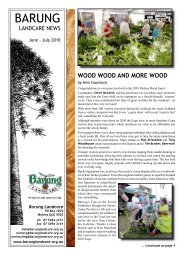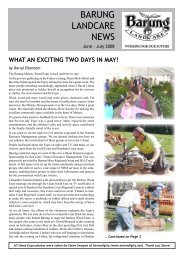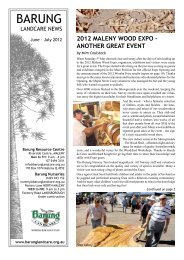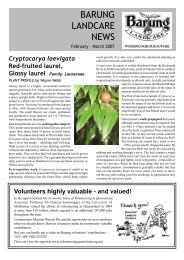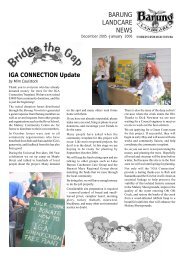Apr/May 2007 - Barung Landcare
Apr/May 2007 - Barung Landcare
Apr/May 2007 - Barung Landcare
You also want an ePaper? Increase the reach of your titles
YUMPU automatically turns print PDFs into web optimized ePapers that Google loves.
Down and dirty for the IGA<br />
by Mim Coulstock<br />
On Saturday 3 rd March, about 70 Maleny locals planted more<br />
than 500 trees in less than two hours on the IGA Connection site<br />
at the Maleny Showgrounds. This planting almost completed the<br />
first stage of the IGA Connection Project which began last year.<br />
The project was initiated by <strong>Barung</strong> <strong>Landcare</strong> as a way for the<br />
community to recognise the enormous support extended to our<br />
many local community groups by Rob and Samantha Outridge<br />
of Maleny Supa IGA.<br />
Saturday’s planting will greatly enhance the weed control and<br />
planting done by <strong>Barung</strong> Green Corps teams and others over the<br />
past 12 months and will strengthen the connection between the<br />
Showground’s remnant rainforest and Obi Obi Creek, via the<br />
riparian zone of the little creek bordering the eastern side of the<br />
Pony Club area.<br />
Stage 2 of the project will address the 100 m of dense small-leaved<br />
privet infestation growing along the creek just before it joins the<br />
Obi. The privet will be removed and the area revegetated with<br />
a further 500 plus trees, requiring another community treeplant<br />
later in the year!<br />
Caloundra City Council staff are currently being consulted about<br />
how to address the actively eroding point where this creek joins<br />
the Obi, a big job which <strong>Barung</strong> cannot complete on its own.<br />
Signs listing the names of all IGA Connection Project sponsors<br />
were on display at the treeplant and will be erected around the<br />
site very soon. More signs are being made as additional sponsors<br />
come on board. Thank you to everyone who has sponsored trees to<br />
date, and to Rainforest Rescue and Lake Baroon Catchment Care<br />
Group for so generously supporting the whole project.<br />
BARUNG<br />
LANDCARE<br />
NEWS<br />
... continued on page 4<br />
<strong>Apr</strong>il - <strong>May</strong> <strong>2007</strong>
in this issue<br />
IGA Connection treeplant: Down & dirty.......... 1,4<br />
New Members........................................... 2<br />
ORNAMENTAL GARDEN: For the Frugivores......... 3<br />
IBISCA Lamington Project.............................. 3<br />
WILDLIFE PROFILE: Fruit Doves<br />
and Fragmentation................................... 5<br />
Montville SS Bunya Feast.............................. 5<br />
PLANT PROFILE: Corduroy tamarind................. 6<br />
Farm Forestry land for sale........................... 6<br />
Natural Sequence Farming............................ 7<br />
OPPORTUNITIES AND EVENTS......................... 8<br />
NURSERY NOTES: Irrigation benefits................. 9<br />
BARUNG CONTRACTING: Bush Regeneration...... 10<br />
WEED WATCH ONE: BL Paspalum UPDATE.......... 11<br />
GRANT FUNDING....................................... 11<br />
BUTTERFLIES OF THE RANGE: Monarch............. 12<br />
WEED WATCH TWO: Biological control............. 13<br />
WEED WATCH THREE: Weed folders review........ 13<br />
Thank You to, Letters ................................ 14<br />
TURKEY TANGENTIAL: Wilderness Garden..... 16,15<br />
barung membership rates<br />
Individual / family membership $ 20 pa<br />
Business membership<br />
$ 55 pa<br />
Business sponsorship<br />
$275 pa<br />
Donations of $2 or more are tax deductible.<br />
When your BUSINESS supports <strong>Barung</strong> <strong>Landcare</strong>,<br />
you will be acknowledged in the bimonthly<br />
<strong>Barung</strong> <strong>Landcare</strong> News (800 distribution) and at<br />
<strong>Barung</strong> displays, and you are entitled to three<br />
free trees and discounts on plant purchases at<br />
the Nursery.<br />
Contact the office at <strong>Barung</strong> <strong>Landcare</strong> on phone<br />
5494 3151 or email barungadmin@big.net.au<br />
for a form.<br />
WELCOME TO NEW MEMBERS<br />
(Compiled by Val Phillips)<br />
Bill Freeman<br />
John & Ann Wood<br />
Steve Hills<br />
Dal & Pam Fea<br />
Heather Wood<br />
Helen Meredith<br />
Chris Rew<br />
Warren & Janet Ausell<br />
Michael & Renate Cretney<br />
Carolyn Willadsen<br />
Chris & Deb Bourke<br />
B&L McFarlane<br />
Walter Bons<br />
Phil Harrison & Lani Donahaye<br />
McCullah/Steele<br />
Janet Carew<br />
THANK YOU FOR YOUR LANDCARE SUPPORT<br />
Opening Hours<br />
MONDAY TO FRIDAY<br />
<strong>Barung</strong> Nursery & Resource Centre/Office<br />
8.30 am – 4.00 pm<br />
SATURDAY<br />
<strong>Barung</strong> Nursery only<br />
9.00 am – 12.00 pm<br />
DEADLINE – Wed 16 th <strong>May</strong><br />
for June–July <strong>2007</strong><br />
Newsletter contributions<br />
Please renew your membership -<br />
your support is very important<br />
to <strong>Barung</strong>.<br />
THANK YOU<br />
Please keep showing your ...<br />
<strong>Barung</strong><br />
Community Benefit key tags<br />
... when shopping at Maleny IGA<br />
<strong>Barung</strong> gratefully acknowleges funding & sponsorships from:
For the Frugivores<br />
THE ORNAMENTAL GARDEN by Joan Dillon<br />
We’ve had some less common garden visitors lately; two<br />
female regent bowerbirds. We occasionally catch a glimpse<br />
of the gorgeous black and gold male but he doesn’t usually<br />
come so close to the house. The females were attracted by<br />
the fruit on a Decaspermum humile and I was reminded of<br />
the importance of fruiting trees and shrubs to many of the<br />
local birds. Decaspermum with its small leaves and neat<br />
habit is a useful addition to any garden.<br />
Our assorted figs in the revegetation/regeneration always<br />
support a range of pigeons from the wompoo down to the<br />
little greenwings, plus a substantial flock of figbirds and<br />
increasing numbers of lorikeets. The lorikeets are also<br />
attracted to the tiny sweet fruit on the native mulberry<br />
Pipturus argenteus, which the birds do love it as a source of<br />
small insects as well as fruit. Honeyeaters and yellow robins<br />
search amongst the leaves and twigs for tiny caterpillars.<br />
A pioneer species which attracts the brown turtle doves to<br />
its fruit is Homolanthus populifolius, and crows (ravens)<br />
seem to like the fruit of Macaranga tanarius. The bright<br />
purple fruit of Callicarpa pedunculata is both decorative<br />
and popular, as is the creamy coloured fruit of Psychotria<br />
loniceroides. This one comes up all over the place and<br />
I suspect the Lewin’s honeyeaters are responsible for<br />
spreading it. The brush turkeys took a liking to the blue fruit<br />
of Dianella congesta, and just about stripped the plants.<br />
Callicarpa pedunculata fruit. [Photo by Ian Dillon]<br />
Something is enjoying the fruit of the Davidson plum as I’m<br />
finding pecked fruit on the ground, and I’m waiting to find<br />
out what will be attracted to the Acronychia oblongifolia,<br />
now flowering heavily. Varied trillers love the fruit of the<br />
red bean Dysoxylum mollissimum (Dysoxylum muelleri) and<br />
seasonal visitors like the black-faced cuckoo shrike move<br />
from fig to wild raspberry and back again.<br />
The native olives Olea paniculata fruited heavily last year<br />
and kept the figbirds fed for weeks. When I went to collect<br />
some rosewood seed for propagation it was all gone and<br />
there was none on the ground. Something had dined well.<br />
Adding figs to the revegetation mix provides fruit for flying<br />
foxes as well as birds and hopefully reduces the impact on<br />
local orchards. Our resident and visiting frugivores provide<br />
endless pleasure and entertainment and help to disperse the<br />
local species.<br />
<br />
More about the IBISCA<br />
Lamington Project<br />
by Gretchen Evans & Lin Fairlie<br />
Not insects this time, but macrofungi<br />
Last issue of <strong>Barung</strong> News, Petrus wrote<br />
about the IBISCA project. This time we<br />
would like to tell you about an associated<br />
project in which we have been involved,<br />
called BATH – Biodiversity at the Heights.<br />
We are both members of Queensland Mycological<br />
Society (QMS) and have participated<br />
in two macro-fungal surveys, one last<br />
November and one recently in February.<br />
All the 20 sites were not covered because there were only 13<br />
volunteers and 3 days in which to do the surveys. Also there was<br />
only one professional mycologist, Nigel Fechner, who is half-time<br />
on macro fungi at the Queensland Herbarium, but a number of<br />
our colleagues were very knowledgeable.<br />
During our recent visit we discovered, photographed and<br />
described about 150 different specimens. As each new fungus<br />
is found, detailed descriptions of its size, colour and substrate<br />
are recorded and photographs taken. Then, after an identifying<br />
number has been assigned to the specimen, it is collected and<br />
returned to base for further description. Many fungi were really<br />
beautiful with varying colours, shapes and textures. Many were<br />
of the ‘mushroom’ type, but we did find some rare ones such as<br />
a Mutinus sp., which is a type of ‘stinkhorn’, and another which<br />
has never been found in Queensland before, a Chlorosplenium sp.,<br />
which was a beautiful bluey-green ascomycete or cup fungi.<br />
Unfortunately there are ‘weed’ fungi too. We found quite large<br />
infestations of Favolaschia and the spread of this fungus certainly<br />
needs research. However there is very little money available for<br />
macrofungal research, even though there is a growing recognition<br />
of the association between many individual Australian tree<br />
species and specific fungi.<br />
QMS has a regular monthly meeting at 7 pm on the second<br />
Tuesday of each month in the Herbarium lecture room at the Mt<br />
Coot-tha Botanical Gardens. Everyone is welcome. Sunshine<br />
Coast members are planning outings later in the year to look for<br />
local fungi, so we will keep you informed of dates and details.<br />
Driving into <strong>Barung</strong><br />
Sloooowly, please<br />
If you need to bring your vehicle into <strong>Barung</strong><br />
(instead of parking outside), PLEASE drive<br />
very, very slowly and carefully.<br />
The dragons are very nimble, but small children<br />
who may be visiting the plant nursery<br />
don’t have such quick and instinctive reactions<br />
for avoiding vehicles (or any at all,<br />
really).<br />
Please keep <strong>Barung</strong>’s driveway safe.<br />
Drive sloooowly.
IGA Treeplant<br />
... continued from page 1<br />
Many thanks to Montville Mist and our local councillor,<br />
Dick Newman for sponsoring the water and<br />
BBQ for treeplanters who’d been planting in very<br />
hot conditions. Both were greatly appreciated and<br />
enjoyed as they provided a time and place for friendly<br />
conversation after the morning’s work.<br />
Thanks especially to <strong>Barung</strong> Contracting Services,<br />
office staff and the CJP team who all contributed to<br />
the set-up and organisation prior to the treeplant, as<br />
well as giving up their time to ensure the morning<br />
flowed so smoothly.<br />
And finally, an especially big ‘thank you’ to everyone<br />
who planted trees. As Rob Outridge commented,<br />
the morning’s work ‘…demonstrated what fantastic<br />
results can be achieved with teamwork by a diverse<br />
group of enthusiastic and energetic people.’<br />
If you would like to sponsor a tree by donating at least<br />
$10 towards the IGA Connection Project and have<br />
your name added to a permanent sign at the site, please<br />
phone <strong>Barung</strong> (5494 3151) or call into the office in<br />
Bicentenary Lane and leave your details.<br />
Page 1, anticlockwise from top: Jake and some <strong>Barung</strong><br />
babies; Rob, Emily, Lucy & Sam Outridge; Diana O’Connor;<br />
the famous <strong>Barung</strong> bar-be-que and ’ave-a-chat tent.<br />
This page, clockwise from top: the <strong>Barung</strong> community crew<br />
putting the <strong>Barung</strong> babies to bed; Ryan & Wayne Webb,<br />
Brosie & John Muir and Banjo Brunckhorst; Emma’s children<br />
from Rainforest Rescue.<br />
[Photos by Mim Coulstock and Fuschia Collard]<br />
<strong>Landcare</strong> Queensland<br />
[Virtual] Bookshop<br />
With a focus on all things landcare related, the new<br />
<strong>Landcare</strong> Queensland online bookshop provides<br />
publications on working and playing in the natural<br />
environment. Members of <strong>Landcare</strong> Queensland<br />
receive a discount (membership is only $20 a year.<br />
If you have requests for publications, please email<br />
kerri@landcare.com.au<br />
Join <strong>Landcare</strong> Queensland<br />
Join <strong>Landcare</strong> Queensland before 15 <strong>Apr</strong>il and receive<br />
Kangaroos of Queensland (RRP $12.95) for free.<br />
(You must write ‘free kangaroos book’ on your form<br />
to receive the publication.)<br />
Phone: 07 3211 4413<br />
Website: www. landcare.org.au<br />
‘From waste-d-water to pure water’<br />
Water Quality Star Rating<br />
by Jenifer Simpson<br />
Jenifer Simpson’s guide builds a case for rethinking our attitudes to waste-dwater.<br />
In this highly readable guide, we discover what we put into water, how<br />
we take it out again and how we can be sure that it has been taken out.<br />
Moving away from the largely misunderstood ‘primary, secondary, tertiary’<br />
descriptions of effluent quality, Jenifer introduces a stunningly logical concept<br />
– she awards stars. The more stars, the more opportunities to reuse this precious<br />
resource – simple and straight forward – just like the booklet itself.<br />
Cost:<br />
FREE to community groups and individuals<br />
Online: www.scec.org.au/pdfs/From-waste-d-water-to-pure-water.pdf<br />
Contact: Natasha Wright on 3503 1425 or<br />
nwright@seqcatchments.com.au<br />
Support <strong>Barung</strong> <strong>Landcare</strong> through your Business<br />
Forms available from <strong>Barung</strong> <strong>Landcare</strong> Office
Fruit Doves and<br />
Fragmentation<br />
WILDLIFE PROFILE by Susie Duncan<br />
Fruit doves are real jewels in our local rainforests. The<br />
wompoo fruit-dove is possibly the best known because<br />
of its wacky but beautiful call ‘wolloka - ooo’. These are<br />
large doves, around the size of a currawong, but they’re<br />
often unseen because of their quiet movements in the dense<br />
rainforest foliage. Falling fruit can often be the first signal<br />
that they’re up there. Once seen they are unforgettable, with<br />
their rich plum purple chest, deep yellow underparts, bright<br />
green back and tail, and white head.<br />
The other two fruit doves are about half the size of the<br />
wompoo and also very brightly coloured: the superb fruitdove<br />
male has a beautiful purple crown and the rose-crowned<br />
fruit-dove male and female both have rose crowns.<br />
These birds are serious fruit eaters (frugivores) of the<br />
rainforest and are quite particular about what fruits they<br />
will eat. A study by Cath Moran and others (2004) in the<br />
Blackall and Conondale ranges showed that in this region<br />
fruit doves were most abundant in the extensive tracts of<br />
rainforest that remain. They were much less abundant in<br />
smaller rainforest remnants, and even more rare in patches<br />
of regrowth rainforest.<br />
These three species are known to fly across cleared land, so<br />
what was stopping them from hanging out in the remnants<br />
(which had similar food plants to the extensive tracts of<br />
rainforest) and the regrowth? It was fairly evident that the<br />
pioneer vegetation of the regrowth often didn’t have the<br />
right food plants or they weren’t yet bearing enough food<br />
to be attractive to the fruit doves. But with the remnants,<br />
the answer seems to lie in reward for effort. Flying long<br />
distances across cleared land without a refuelling site along<br />
the way just doesn’t make energetic sense for a fruit dove.<br />
In extensive areas of rainforest they can more readily cover<br />
big distances because there are sure to be a few snacks enroute.<br />
And of course, flying across open country also carries<br />
the risk of becoming dinner for a raptor such as a peregrine<br />
falcon. So not too many fruit doves end up in remnants,<br />
even though there might be fruit available.<br />
In the story of the fruit doves, the implications are not just<br />
for the conservation of the birds, but also the rainforest<br />
plants whose seeds they distribute. Other frugivores which<br />
eat a wider range of fruits may not distribute some of the<br />
fruits that the fruit doves eat. For example, fruit doves are<br />
known to be able to swallow larger fruits and seeds than<br />
most other frugivore birds by virtue of their distensible<br />
gapes. They also have ‘lump-lined stomachs’ which might<br />
treat seeds differently from other frugivores and result in<br />
greater germination success.<br />
The upshot of all this is that in remnant and regrowth<br />
rainforest the decline of fruit doves is likely to lead to a<br />
decline in plants whose seeds they specifically distribute.<br />
This will be particularly so where those fragments of<br />
rainforest are distant from extensive areas of rainforest. In<br />
effect there may be local extinctions of some plant species<br />
<br />
in isolated fragments, and it is quite likely that the weed<br />
species that other frugivores distribute (camphor laurel,<br />
privets, lantana) will increase.<br />
So what can we do for these beautiful birds and their<br />
favourite food plants? We can direct-seed or replant these<br />
species in the fragments. But in the long run we need to<br />
recover the connections between extensive areas of forests,<br />
remnants and regrowth. Not narrow corridors, but broad<br />
bands of forest that will provide contiguous cover and food<br />
for all the species integral to the rainforest.<br />
Reference: C Moran, CP Catterall, RJ Green and MF Olsen<br />
(2004) Fates of feathered fruit-eaters in fragmented forests.<br />
In Conservation of Australia’s forest fauna (2 nd ed.), edited<br />
by Dan Lunney.<br />
Montville State School<br />
Annual Bunya Feast<br />
by Frith Duggan<br />
Have you noticed that the Montville School logo is a bunya<br />
tree?<br />
For several years now, Montville State School students have<br />
been involved in celebrating the bunya feasts which are part of<br />
the Gubbi Gubbi history in this area. There has been Aboriginal<br />
dancing, stories and bush tucker food. All year levels and lots of<br />
parents participate at this half-day celebration, which is usually<br />
held in March while there are still plentiful bunya nuts.<br />
Traditionally bunya feasts were held every third year. After last<br />
year’s gigantic event in the Family Russell Park, the Montville<br />
State School P&C organised a smaller event for this year on<br />
Monday 12 March at the Montville Village Green.<br />
The whole school was delighted to hear Beverly Hand from the<br />
Gubbi Gubbi tribe present<br />
an interactive talk with<br />
students before trying<br />
some roasted bunya nuts.<br />
Montville State School<br />
and the P&C feel very<br />
privileged that Bev could<br />
pass on traditional knowledge<br />
and heritage which is<br />
such an important part of<br />
this area’s history.<br />
Thank you Bev! We can’t<br />
wait to hear the story<br />
about the wedge-tailed<br />
eagle.<br />
Bev Hand was<br />
invited to speak<br />
at Montville<br />
State School’s<br />
Bunya Feast.<br />
[Photos by<br />
Fuschia Collard]
Mischarytera lautereriana<br />
Corduroy tamarind<br />
Family: Sapindaceae<br />
PLANT PROFILE<br />
by Wayne Webb & Diana O’Connor<br />
Mischarytera lautereriana is a very<br />
handsome tree on account of its dense<br />
elegant foliage. The leaves are compound,<br />
about 25 cms long, divided into 10 to 20<br />
narrow leaflets with wavy margins giving<br />
a lovely feathery look to the foliage. The<br />
shiny leaflets are hairless, bright green<br />
and entire with small teeth near the apex.<br />
There is a large pulvinus (swelling) at the<br />
base of the leaf stem. Bright red flushes of<br />
new growth are very ornamental.<br />
Corduroy tamarind is a small to medium<br />
sized tree of subtropical rainforest growing<br />
to around 15 m, although old specimens to<br />
30 m can be found in mature rainforests.<br />
It occurs north from Mt Glorious (near<br />
Brisbane) to the Windsor Tableland<br />
(west of the Daintree). It is endemic to<br />
Queensland. It is quite common locally,<br />
often found close to watercourses. Examples may be seen in<br />
Mary Cairncross Scenic Reserve down near the piccabeen<br />
grove. Other places include Flaxton, Elaman Ck, Peachester,<br />
Landsborough and Mapleton.<br />
The trunk has horizontally ridged grey bark, common in<br />
this family. The common name comes from the strangely<br />
undulating sapwood (like corduroy) lying below the bark,<br />
and the sharp taste (like tamarind) of the fruit’s edible aril.<br />
Corduroy tamarind bears tiny fragrant flowers in panicles<br />
near the ends of branches in <strong>May</strong> and June. It usually<br />
by Ashley Sewell and Mim Coulstock<br />
Mischarytera lautereriana<br />
[Photo by Wayne Webb]<br />
When Patricia and Phil Jacobs came from Sydney to Maleny in<br />
1991, they purchased a 2.6 ha property on Gardners Lane and<br />
proceeded to build their house and to rehabilitate and landscape<br />
the surrounding ex-dairy farm land. With their strong commitment<br />
to the community, especially when <strong>Barung</strong> <strong>Landcare</strong> was in its<br />
infancy with Lexie Forbes at the helm, Patricia and Phil provided<br />
invaluable support operating and even building the office.<br />
Phil and Patricia were early and strong supporters of what was to<br />
become known ‘farm forestry’. Using the ‘Jack Mitchell Method’<br />
of planting 10-12 species of cabinet timbers per hectare, two<br />
small 1000 m farm forestry plots were established in 1992-94 on<br />
their property in Gardners Lane. These plantings have been very<br />
successful, and have provided sound demonstration opportunities<br />
for interested and potential farm forestry growers in the region.<br />
Phil and Patricia’s sites are still used for <strong>Barung</strong> Farm Forestry<br />
tours for local, school and overseas visitors.<br />
Since Phil passed away in 2001, Patricia has maintained their<br />
property in excellent condition in his absence. However, to make<br />
<br />
fruits in November and December (though in <strong>2007</strong> fruiting<br />
occurred in January). Like many rainforest species, it may<br />
fruit heavily in some years and hardly at all in other years.<br />
The fruit is a three-lobed capsule (although often only one<br />
lobe will develop) that opens upwards to expose the fleshy<br />
orange aril which encases a large brown seed.<br />
Corduroy tamarind makes a very attractive garden or park<br />
tree. Young trees have a stately conical outline,<br />
with a dense canopy of beautiful wavy foliage.<br />
Older trees develop a rounded crown. This<br />
species is hardy in full sun, tolerates light frost,<br />
and will grow in a variety of soils including<br />
shallow infertile soils. It establishes faster with<br />
some protection and good mulching when<br />
young. Larger trees in the rainforest often have<br />
a carpet underneath of young ones often up to<br />
one metre high. This suggests it could be mass<br />
planted in heavily shaded areas of the garden<br />
to produce a beautiful ferny understorey, the<br />
low light levels suppressing growth.<br />
The juicy orange aril is edible, though very<br />
tart. If removed carefully when cleaning the<br />
seed, the aril can be used to make a fantastic<br />
bright orange ‘bush-tucker’ jam – great with<br />
scones and whipped cream! The fruit is also<br />
sought out by rainforest birds such as the<br />
wompoo fruit-dove. The wood of this species has been used<br />
for flooring and scantling.<br />
Corduroy tamarind is easily propagated from seed, which<br />
germinates in a few weeks. The seed is subject to insect<br />
attack while on the tree, so when collecting soak the seed<br />
overnight in water to drown any grubs. Remove the flesh<br />
and discard any seeds that are distorted before sowing. If<br />
seeds can’t be sown immediately, they may be soaked for<br />
one or two weeks; they will loose viability if allowed to<br />
dry out for too long.<br />
Phil and Patricia Jacobs: <strong>Barung</strong> & Farm Forestry Stalwarts<br />
the property more manageable for herself, she has decided to<br />
subdivide and sell one block, containing one of the farm forestry<br />
plots, hopefully to a sympathetic farm forestry or landcaring<br />
enthusiast.<br />
It is hoped that the purchaser will continue to permit <strong>Barung</strong><br />
<strong>Landcare</strong> to use the forestry plot for demonstration and educational<br />
purposes.<br />
FARM FORESTRY LAND FOR SALE<br />
1.021 hectares of ‘Farm Forestry’ land<br />
including a mixed species cabinet timber tree plot<br />
and spring-fed dam<br />
in North Maleny<br />
(part of the property of the late Phil Jacobs)<br />
Phone: Patricia Jacobs on 5494 3464
Australian Landscapes:<br />
How they work, how to read them, how to fix them<br />
by Jonothan Waites<br />
Wouldn’t we all like to know? Peter Andrews, of Australian Story<br />
fame (or infamy!) and author of Back from the Brink, has been<br />
studying Australian landscape processes for more than 30 years.<br />
The result of his observations is a land management methodology<br />
he calls Natural Sequence Farming (NSF). NSF is based on<br />
Peter’s theory of how nutrients (carried by water) flow through<br />
and are recycled within our landscapes with the essential aid of<br />
vegetation.<br />
<strong>Barung</strong> <strong>Landcare</strong> recently supported Rosetta Books (as part of<br />
their author series of talks) in hosting an evening talk by Peter<br />
where he outlined his theory and some of its aspects to an interested<br />
audience in the Maleny Showgrounds Pavilion.<br />
NSF as a land management tool is a holistic (and therefore potentially<br />
ecological) approach to evolving landscapes to mimic the<br />
pre-European (or even pre-homo sapiens) valley floor feature<br />
known as the ‘swampy meadow – chain of ponds complex’.<br />
Through many years of keen observation, Peter has identified<br />
landscape functions and recognised the natural sequences which<br />
occur within them that enable ecosystems on this continent<br />
to endure. One such feature is landscape water storage. In the<br />
northern hemisphere water tends to be stored in large open water<br />
bodies. However in our dry, hot continent with high evaporation<br />
rates, water was stored successfully in the soil of the floodplain;<br />
Peter likens such floodplain storage to grass-covered dams.<br />
According to scientist John Williams (Founding member of the<br />
Wentworth Group of Concerned Scientists, Commissioner for<br />
Natural Resources for NSW), NSF is about how landscapes work,<br />
how to read them and how to put them back together again.<br />
Essentially, applying NSF techniques reconnects streams and<br />
rivers to the valley landscapes (catchments) through which they<br />
flow. This is important in terms of ecosystem function because it<br />
allows water (and the nutrients it transports) to be retained within a<br />
landscape for longer. This gives the plants growing there a longer<br />
period of access to these resources, ensuring them a better chance<br />
of reaching their greatest productive potential. The rate of water<br />
flow through a landscape is considerably slowed and its energy<br />
dissipated by the introduction of structures such as ‘leaky weirs’.<br />
These structures may consist of substantial engineering works<br />
(eg banks, barriers) or simple obstructions (eg rocks, sediments,<br />
trees, branches, leaves, grass).<br />
Valley floors are the fertility collection zone of a landscape. Valley<br />
floors which have a functional ‘chain of ponds’ floodplain system<br />
slow the movement of fertility through the landscape, facilitating<br />
the uptake of minerals and nutrients by plants which are then consumed<br />
by livestock, birds and bees. These animals then transfer<br />
that fertility to the top of the hills from whence water (aided by<br />
gravity) spreads it back down the slope (moving both above and<br />
below the ground). This is one of nature’s many cycles by which<br />
landscapes sustain themselves.<br />
An ideal farm layout, Peter believes, is one that is divided into<br />
thirds as follows; one-third forest and scrub (on the high ground<br />
– accumulating fertility under the trees), one-third agricultural<br />
(mid-slope – cropping, exploiting fertility) and one-third recovery<br />
area (valley floor – grass and weeds capturing fertility).<br />
Now these figures aren’t hard and fast, and the pattern could<br />
also be repeated several times on a slope, in a paddock or over a<br />
property. In a grazing situation it would be two-thirds grassland<br />
and one third forest area, with the forest area being selectively<br />
<br />
grazed (this, of course, depends on the purpose of the forest and<br />
other associated factors – not rainforest remnants please). Peter<br />
suggests that applying this method aimed at accumulating and<br />
retaining nutrients can result in the agricultural third being up to<br />
five times more productive. This is based on the supposition that<br />
pasture grass and crops extract fertility while weeds and trees<br />
add fertility to the land.<br />
A brief word about weeds. Many of the critics of NSF have made<br />
much of Peter’s use of weeds, particularly the dreaded willow.<br />
Peter doesn’t divide plants into natives and exotics, but rather<br />
assesses a species according to its function in the landscape. He<br />
regards many of our herbivorous weeds as great fertility accumulators<br />
which only occur in a landscape to correct a mineral<br />
deficiency or a particular soil condition. Willows, he contends,<br />
have functioned more successfully than natives would have where<br />
he has used them for the specific purposes he has had in mind.<br />
Focussing on one aspect, such as the use of weeds or a particular<br />
weed species, can distract us from the key principles of NSF, with<br />
the result that we miss the point.<br />
It is claimed that NSF properly applied can rectify a range of<br />
environmental problems such as salinity, erosion, eutrophication<br />
of waterways, and rising water tables. A CSIRO team was formed<br />
to evaluate the performance of NSF at Peter Andrew’s property<br />
‘Tarwyn Park’ in the Hunter Valley. Its report endorsed the general<br />
approach. In other words, ecologically NSF makes sense. Apart<br />
from the science, practical results speak for themselves. Photos<br />
of Peter’s property during the current drought show a body of<br />
green feed covering his valley floor, in stark contrast to the brown<br />
paddocks of neighbouring properties.<br />
The report also concluded that more monitoring and evaluation of<br />
NSF was needed in other areas along with its practical application<br />
in other landscapes.<br />
Funding available to trial NSF<br />
To this end, the regional body SEQ Catchments has obtained<br />
funding to set up some trials in this region. If you are interested<br />
in trialling NSF on your property, please contact me at <strong>Barung</strong><br />
<strong>Landcare</strong> or SEQ Catchments directly. It would be interesting<br />
to investigate NSF’s applicability to our landscapes with their<br />
predominance of first order streams and to determine just how<br />
the methodology might be practiced here. In an area such as ours<br />
with intensive agricultural land use, an increasing population and<br />
high rainfall (well usually), a management approach that enhances<br />
the retention of our increasing nutrient loads on the land and out<br />
of our streams deserves to be considered.<br />
This has been a necessarily brief overview of NSF; a simple<br />
system but a complex one to implement on a specific property<br />
or landscape. Only some of the environmental aspects have been<br />
touched on here, and there are also social and economic implications<br />
that need to be thought through. The <strong>Barung</strong> Library has a<br />
copy of Peter Andrews’s book Back from the Brink: How Australian<br />
landscapes can be saved available for loan to members as well<br />
as a double DVD, Natural Sequence Farming Workshop: Defining<br />
the science & the practice. There are also two websites:<br />
www.nsfarming.com and www.naturalsequencefarming.com.au<br />
I would encourage all readers (landholders in particular) to further<br />
explore NSF through these sources and consider how the principles<br />
might be applied to their own landscapes.
OPPORTUNITIES & EVENTS<br />
Native Forest Management<br />
5 Day Workshop Series<br />
Day 1:<br />
Time:<br />
Where:<br />
Wednesday 18 <strong>Apr</strong>il<br />
9.00 am – 3.00 pm<br />
Cooloola Shire Council Rifle Range Block,<br />
opposite Victory Store, Bath Terrace, Gympie<br />
Native forest management workshops one day per fortnight for 10<br />
weeks. Usually from 9.00 am to 3.00 pm, visiting participant’s<br />
properties. Covers legislation, stand assessment, management<br />
timeline, contractor management, timber sales, post-harvest<br />
management, and regeneration. Teas and lunch supplied.<br />
Cost for 5 days: $330.00 per Farm Enterprise<br />
(special deal for registration by 5 <strong>Apr</strong>il)<br />
Contact: Ken Matthews on 5483 6535 or<br />
pfsq@bipond.com<br />
Managing Weeds on Rural Res Land<br />
When: 28 <strong>Apr</strong>il, 9 am – 4 pm<br />
Where: CREEC, 150 Rowley Road, Burpengary<br />
Caboolture Shire Council, SEQ Catchments & PRCCA workshop<br />
to help landholders identify and manage common bushland and<br />
environmental weeds on their property. Bring a bag of weeds to<br />
swap for native plants. Free (limited to first 30 registrations).<br />
RSVP: by Friday 20 <strong>Apr</strong>il to Cheryl Regan or<br />
Julie Caught on 5420 0294<br />
Fungimap Conference<br />
When: 31 <strong>May</strong> – 5 June <strong>2007</strong><br />
Where: Natural Bridge, Gold Coast hinterland<br />
Forays, talks and workshops covering a wide range of topics – for<br />
beginners to advanced fungi lovers.<br />
More info: www.fungimap.rbg.vic.gov.au or<br />
03 9252 2374<br />
9 th Queensland Weed Symposium<br />
Everything you wanted to know about Queensland weeds!<br />
When: 3-6 June <strong>2007</strong><br />
Where: Surfers Paradise<br />
Organised by the Weed Society of Queensland, the conference<br />
should be of interest to local government weeds officers,<br />
state agency officers, chemical company reps, agribusiness,<br />
private consultants, students and landholders, community group<br />
members such as Bushcare, <strong>Landcare</strong> and catchment management<br />
groups.<br />
More info: www.wsq.org.au/9thweedsymposium<br />
Found & Found<br />
After Bunya Dreaming: child’s blue thongs, child’s<br />
red ladybird thongs, small pair of girl’s joggers<br />
At IGA Treeplant: child’s floral hat, black knitted vest<br />
At <strong>Barung</strong> Office: denim Cool Carry lunch bag, pair of<br />
leopard-skin-framed reading glasses<br />
<br />
Botanical Information Field Workshop<br />
When: Saturday 16 June <strong>2007</strong><br />
Times: 8.30 am to 4.00 pm, carpooling from <strong>Barung</strong><br />
Identifying trees and where they sit in the landscape under the<br />
regional ecosystem process, especially from a landzone and<br />
geology aspect. Includes informative booklet.<br />
To book:<br />
Bring:<br />
Phone <strong>Barung</strong> on 5494 3151 by Wed 13 June<br />
boots, water, hat, sunscreen, morning tea, lunch<br />
(or buy at Mary Cairncross)<br />
More info: Ashley Sewell on 5451 2267 or<br />
ashley.sewell@nrw.qld.gov.au<br />
Recovering Rainforest<br />
Queensland Rainforest Forum<br />
When: 25–27 June <strong>2007</strong><br />
Where: Griffith University, Brisbane<br />
The Queensland Rainforest Recovery Forum will showcase<br />
community projects, rainforest science, and recovery planning,<br />
management and conservation. Keynote presenters include<br />
Professor Roger Kitching, Cr Mike Berwick, Bruce Boyes, and<br />
<strong>Barung</strong> and Noosa landcare groups. Hosted by SEQ Catchments<br />
with support from the Australian Government, SEQ Catchments,<br />
<strong>Landcare</strong> Queensland and Centre for Innovative Conservation<br />
Strategies (Griffith University).<br />
More info: <strong>Landcare</strong> Queensland on 3211 4413<br />
Contact: Kerri Woodcock on kerri@landcare.com.au or<br />
0410 936 221<br />
Website: www.landcare.org.au/RRforum07.htm<br />
Queensland <strong>Landcare</strong> Conference<br />
‘Making a Difference ‘<br />
Hosted by Pioneer <strong>Landcare</strong><br />
When: 22–25 August<br />
Where: Mackay<br />
Key speakers include:<br />
• Peter Oliver, long-term landcarer, acclaimed researcher,<br />
<strong>Landcare</strong> poet and wandering minstrel!<br />
• Bobbie Brazil, Chairman of the Australian <strong>Landcare</strong><br />
Council<br />
• Kim McKay, author, marketing expert and co-founder of<br />
Clean up Australia and Clean up the World<br />
Award nominations for the <strong>2007</strong> Queensland <strong>Landcare</strong> Awards<br />
open in <strong>May</strong>. More information available from Queensland Water<br />
and Land Carers on 07 3211 4409 or erin@landcareqld.org.au<br />
Sponsorship opportunities and Trade Exhibition spaces – forms<br />
available from the website.<br />
Join the conference mailing list – for the latest news on registration,<br />
bursaries and associated events.<br />
Website: www.landcare.org.au/Conference.htm<br />
Mini-blog<br />
for snippets of <strong>Barung</strong> news and<br />
interesting info<br />
http://barunglandcare.tumblr.com/
Irrigation benefits<br />
NURSERY NOTES by Wayne Webb<br />
Firstly, I’d like to say ‘thank you’ to Di<br />
O’Connor who has offered to help out with<br />
the preparation of the plant profiles for the<br />
newsletters. It can take considerable time<br />
researching and assembling the information<br />
required, particularly with frequent interruptions,<br />
so Di has started to draft out profiles on<br />
a range of species that we grow. We hope to<br />
create an information series from these plant<br />
notes, for members and nursery customers to<br />
use as an aid to selecting plants.<br />
For those wondering about the disruptions in<br />
our retail section a while back, we have been<br />
replacing some of the old irrigation system.<br />
Old pipe (which was beginning to split) has<br />
been replaced with higher grade pipe, the<br />
sprinkler layout has been improved, and far<br />
more efficient sprinkler heads have been<br />
installed.<br />
Nursery irrigation performance is measured by a catch-can trail<br />
and looks at three parameters – Mean Application Rate (MAR),<br />
Coefficient of Uniformity (Cu) and Scheduling Coefficient (Sc).<br />
MAR should not exceed the absorption rate of the potting media<br />
used, around 15 mm/hr. Cu is a calculation of how evenly an area<br />
is being watered, with 100% being absolute evenness. Sc is a<br />
measure of how many times longer the area needs to be watered<br />
to ensure the driest spot receives enough, expressed as a number<br />
greater than 1.0, with 1.0 being ideal and 1.2 being acceptable.<br />
As can be seen from the table at the bottom of this page which<br />
shows test results for the old and new systems, the new system is<br />
a considerable improvement and should result in a water saving<br />
of some 56% for this area.<br />
Even water application will also avoid some plants suffering from<br />
being too wet (and associated fungal problems) while others suffer<br />
from drought. A lighter application rate combined with more<br />
even water distribution will also reduce nutrient leaching from<br />
the growing media, resulting in healthier plants, less pollution,<br />
and possible savings in fertilizer.<br />
This upgrade of the irrigation system has been made possible by<br />
a grant from Maleny Credit Union’s Community Trust. To them,<br />
a big ‘thank you’!<br />
Thanks also to our trusty volunteers, Max Smith, Duncan Gregor,<br />
Gordon Halliday and Pat Cavanaugh, who beavered away digging<br />
trenches and spreading fresh gravel to cover up the mess. (Pat<br />
thought he was coming along to help with the newsletter folding<br />
and mail-out!)<br />
Other areas of the nursery irrigation will be upgraded as time and<br />
finances permit.<br />
(Left) Before: the old irrigation system, and ponded/<br />
wasted water due to the high application rate<br />
[Photo by Wayne Webb]<br />
(Above) After: Wayne checks the pressure on the<br />
new irrigation system [Photo by Jane Williamson]<br />
Irrigation efficiency parameter Optimal Old system New system<br />
Mean Application Rate (MAR) 15 mm/hr 37.2 mm/hr 17.3 mm/hr<br />
Cooefficient of Uniformity (Cu) 100% 75.9% 91.1%<br />
Scheduling Coefficient (Sc) 1.0 (1.2 is acceptable) 2.32 1.23
THE PARABLE OF BUSH REGENERATION<br />
CONTRACTING SERVICES by Brendan Stephen<br />
A shout-out to the great custodians of this land, the Gubbi Gubbi,<br />
those who looked over this place for countless generations, who<br />
have been here since time immemorial. Acknowledgement also<br />
to the dedication and commitment of the <strong>Barung</strong> Contracting<br />
Services crew; without you amazing people, the local ecology<br />
would be less functional and my existence less rewarding.<br />
Every day in every way we all<br />
are involved in the consumption<br />
of services and products<br />
created and maintained by<br />
the processes of our regional<br />
ecology. Although our landscape<br />
has been heavily fragmented<br />
through the many<br />
externalities of the contemporary<br />
‘civilisation’ we are<br />
involved in, the generation of<br />
clean water, the atmospheric<br />
diffusion of harmful particles<br />
and the protection and production<br />
of a fertile and stable soil<br />
resource has continued.<br />
The relevance of the onground<br />
works of not just <strong>Barung</strong> Contracting<br />
Services, but of all of the<br />
regional providers of conservation<br />
work, is evident to even the greatest<br />
sceptic. <strong>Barung</strong> Contracting Services appreciates those in the<br />
community involved in the restoration of our region; you should<br />
all be commended for your efforts.<br />
A freshwater wetland community in the Glasshouse area has been<br />
a focus for <strong>Barung</strong> Contracting Services over the past two months.<br />
The general externalities of urbanism were threatening this system,<br />
primarily noxious weed species, feral animals, sedimentation and<br />
general pollutant particles. By removing several weed species,<br />
deconstructing habitat for feral animals, and revegetating a buffer<br />
area outside the resilient core, we contributed to significantly<br />
mitigating these threats. A further area was the focus of additional<br />
revegetation works. At the confluence of several drainage lines, a<br />
detention basin planted with a large matrix of sedges, rushes and<br />
ferns was established to trap sediments and particles before they<br />
reach and are deposited into the wetland community.<br />
BCS manage a large number of existing revegetation projects,<br />
planned and performed by our team, which have been keeping us<br />
very busy. We’ve been working in subcatchments of the Obi Obi,<br />
Bridge, Elaman, London, Coochin and Kidaman creek systems.<br />
The welcome rain has provided ideal conditions for revegetation<br />
projects to be completed; the lower temperatures and saturated<br />
soils certainly give the stock the best starting chance for success<br />
and ensure a fun and wet day for the <strong>Barung</strong> Contracting Services<br />
crew. Whenever that revered moisture descends from the clouds,<br />
our crew just gets downright crazy.<br />
The performance and onground track record of <strong>Barung</strong> Contracting<br />
Services has ensured that<br />
our crew is an industry leader in the<br />
delivery of conservation outcomes.<br />
The geographical range of BCS<br />
is expanding, providing us with<br />
the opportunity to work with an<br />
increased range of vegetation communities,<br />
at different altitudes, on<br />
many different soil types, and this<br />
has necessitated further expanding<br />
our crew.<br />
The <strong>Barung</strong><br />
Contracting<br />
Services crew<br />
(above) now<br />
includes Pete<br />
(left).<br />
Local long-time resident, Pete, has<br />
more than twenty years’ experience<br />
in bush regeneration. He is involved<br />
in many projects in the local area and<br />
brings a large knowledge base of<br />
local species, dynamics and restoration<br />
techniques.<br />
Juliette owns a property in the<br />
Brooloo area, north of Kenilworth,<br />
backing onto protected areas associated<br />
with the Imbil State Forest estate. The enthusiasm and<br />
commitment she demonstrates, coupled with her quick wit and<br />
delivery, ensures her a place on the BCS crew. And the return of<br />
the Contracting Genesis Officer, Jolyon, has lifted our spirits and<br />
increased the crew’s commitment even further to the protection<br />
and enhancement of the vegetation resource that exists today.<br />
The personalities of the BCS crew generates an onground working<br />
environment where commitment, determination, experience and<br />
general professionalism is as tangible as humour, political evaluation,<br />
personal upliftment and mutual respect. The relationship<br />
the BCS crew has with each other, our client base, other <strong>Barung</strong><br />
employees, volunteers and associates and the general community<br />
provides the ideal setting for the delivery of onground regeneration<br />
and revegetation projects with achievable outcomes in an<br />
efficient and effective manner.<br />
BARUNG<br />
CONTRACTING<br />
SERVICES<br />
for landholders<br />
√ reveg, regen & farm forestry<br />
√ project management - planning,<br />
site prep, planting, maintenance<br />
√ weed identification & control<br />
√ property planning & consultancy<br />
√ environmental landscaping<br />
ring Brendan - 0429 943 156<br />
or <strong>Barung</strong> Office - 5494 3151<br />
10<br />
Above: Detention basin planted by <strong>Barung</strong><br />
Contracting Services. [Photos by Brendan Stephen]
Broad leaf paspalum UPDATE<br />
by John Wightman<br />
Jane Morton from the Herbarium visited recently to investigate<br />
the extent of the broad leaf paspalum (BLP) infestation on the<br />
Blackall Range and foothills, accompanied by Sue Phillips, John<br />
Muir, Bede Mackenzie and myself.<br />
Jane and Sue confirmed that all sightings of BLP were kosher<br />
– except for the plant featured in the last issue of the <strong>Barung</strong><br />
Newsletter! That particularly photogenic tussock was in an extensive<br />
BLP infestation – but was not actually BLP.<br />
Diagnostic features for BLP are:<br />
• A spreading habit, with<br />
a tendency to swamp<br />
neighbouring plants<br />
• Broad leaves more than 10<br />
mm wide<br />
• Emerald green leaves<br />
(straight from a child’s<br />
paint box)<br />
• A characteristic crinkling<br />
on the leaf margins<br />
• Seed heads alternating<br />
down the stem, and<br />
flopping downwards<br />
• About 40 seeds on a seed<br />
‘stem’ and about10 seed<br />
stems on a seed head<br />
• Stem bases red-burgundy-brown for about 70 mm<br />
• Roots growing from nodes on the stems at ground level.<br />
GRANT FUNDING Open ...<br />
Caloundra City Council<br />
NRM Small Grants Program<br />
Applications close: Thursday 5 <strong>Apr</strong>il <strong>2007</strong><br />
Rural landholders across the city are again invited<br />
to apply for funding to undertake natural resource<br />
management projects on their properties. The small<br />
grants (up to $1000) fund projects that will have<br />
long term benefits for the wider community, our<br />
local environment and waterways.<br />
More info: Nick Clancy on 5420 8200<br />
Envirofund (Round 9)<br />
Applications close: 27 <strong>Apr</strong>il <strong>2007</strong><br />
There are a couple important changes for this<br />
Round: the rate at which volunteer in-kind time<br />
can now be calculated is $30/hr, and more funds<br />
are available to fund coastal based projects.<br />
Info packs: www.nht.gov.au/envirofund/<br />
More info: 1800 303 863 or envirofund@daff.gov.au<br />
Renew your <strong>Barung</strong> membership<br />
or buy books from <strong>Barung</strong>’s Bookshop<br />
over the phone<br />
with your credit card<br />
Broad leaf paspalum Paspalum mandiocanum<br />
[Images courtesy of Brian Phillips]<br />
Weed Spotters<br />
Be part of a national network identifying new & emerging<br />
weeds! Website, newsletters, manual for collecting<br />
specimens:<br />
www.weeds.crc.org.au/projects/project_4_2_2.html<br />
Contact: Jane Morton on (07) 3896 9467 or<br />
jane.morton@epa.qld.gov.au<br />
Threatened Species Network<br />
Community Grants (Round 10)<br />
Applications close: 5 pm 1 June <strong>2007</strong><br />
Community groups are invited to apply for up to<br />
$50,000 to conduct on-ground conservation work<br />
for the ongoing health of our natural environment,<br />
specifically targeting the needs of nationally threatened<br />
species and ecological communities.<br />
Info packs: www.wwf.org.au/tsn<br />
Phone: 1800 032 551<br />
Maleny Credit Union<br />
Charitable Trust Community<br />
Grants<br />
Open from: 1 <strong>May</strong> <strong>2007</strong><br />
Applications close: 30 June <strong>2007</strong><br />
The MCU Charitable Trust is a tax deductible, tax exempt Trust<br />
established by the Maleny Credit Union to<br />
assist financing local non-profit community<br />
groups whose activities enhance the local<br />
environment, alleviate poverty and generally<br />
help improve the living conditions for those in<br />
the Maleny and district communities. Applicants<br />
must be established community organisations<br />
that are based or operate within the greater Maleny area.<br />
Phone: Maleny Credit Union on 5494 2144<br />
Website: www.malenycu.com.au<br />
11
WANDERER<br />
Danaus plexippus<br />
BUTTERFLIES OF THE RANGE by Bob Miller<br />
Known in the newer butterfly books as the monarch, this is one<br />
example of the problems of using ‘common names’ when referring<br />
to a butterfly. I have noticed just recently that the blue triangle<br />
Graphium sarpedon choredon has also been called a ‘wanderer’<br />
in the past. An old timber-getter from Maleny told me that he<br />
and his fellow timber-getters used to refer to the ‘monarch’ as<br />
‘the brown bunyip’.<br />
Like most butterflies, the ‘common’ name for the butterfly depends<br />
on where you come from!<br />
Both male and female wanderers are approximately 93 mm across<br />
the wingtips. On the upper sides, they are the brightest of orange<br />
in colour, with prominent black veins and a narrow black band<br />
with white spots running around the border. The undersides are<br />
very similar to the upper sides, but the colour is more yellow<br />
than orange.<br />
Males can be distinguished from females by looking at the hind<br />
wings carefully. The males have a ‘sex spot’ on the second vein up<br />
from the bottom of the wings; this spot is absent in the females.<br />
The egg of this butterfly is fairly large and higher than it is wide.<br />
The eggs are white to yellow and stand out prominently on the<br />
leaves, stems and tips of the plant on which they are laid.<br />
Everybody knows the larvae of this butterfly, as it seems to be<br />
the butterfly most commonly raised by kids.<br />
When fully grown, the larvae are approximately 60 mm long.<br />
They are white with yellow and black bands running around the<br />
body. Around winter time, I have sometimes found larvae that<br />
are a lot darker than normal; the darker colouration may assist in<br />
thermal regulation during colder weather.<br />
The pupa of this butterfly is something to behold. It is about 25<br />
mm long, shiny lime green with a glossy black band near the<br />
abdomen and gold spots you would swear were painted on the<br />
pupa using 24 carat gold. They are always found hanging upside<br />
down, sometimes a fair distance from the food plant. I think this<br />
may be a way of escaping the parasites that take a heavy toll on<br />
this butterfly.<br />
When I was a kid, I picked up a dead gum tree branch which<br />
had lots more smaller branches radiating from it. As the larvae<br />
Above: Danaus plexippus adult.<br />
Below left to right: adult; larvae; pupa.<br />
[All photos by Bob Miller]<br />
were about to pupate, I placed them on the main branch. They<br />
would crawl along the branch until they found a suitable position,<br />
anchored themselves, hung upside down, and pupated. In the end<br />
I had a miniature Christmas tree adorned with about fifty of these<br />
green and gold baubles. In less than two weeks all of the baubles<br />
changed colour to black and orange and emerged almost all at<br />
the same time into perfect adult butterflies.<br />
Unfortunately the only food plants of this butterfly are pasture<br />
weeds and cannot be recommended for use as garden plants. I<br />
actually planted both of the most common food plants, Asclepias<br />
curassavica and Gomphocarpus fruticosa, in my garden in Landsborough<br />
to gauge the weed potential in a suburban garden situation.<br />
I found the red and yellow flowered Asclepias didn’t cause<br />
much of a problem, whereas the white flowered Gomphocarpus<br />
spread quite rapidly. Another upside of this was that the butterflies<br />
also seemed to prefer the Asclepias – maybe this was why it was<br />
kept under control.<br />
Again, I am not recommending the planting of this weed, but if<br />
you are contemplating using a corner of your garden as a Wanderer<br />
breeding area, make sure it is a corner where the wind-borne seeds<br />
cannot escape into pastures.<br />
Further information on this or any other butterfly can be had by<br />
reading ‘Butterflies of Australia’ by Michael Braby, 2000, a copy<br />
of which is in the nursery office at <strong>Barung</strong> <strong>Landcare</strong>.<br />
12
Biological Control of<br />
Weeds – Why and How<br />
WEED WATCH by John Wightman<br />
Blackall Range Weeds Task Force<br />
As I see it, plants become weeds for two reasons. Firstly,<br />
they live in an environment that really suits them, in terms of<br />
soil conditions, rainfall and temperature. Secondly, they are,<br />
to a large extent, unregulated by natural control factors. This<br />
means they have few or no serious pathogens (fungal, viral<br />
or bacterial diseases) or arthropod or mammal defoliators,<br />
leaf miners, seed and stem borers, gallers, root eaters, etc.<br />
Going a little further, we can observe that weeds have come<br />
from overseas without bringing old or being found by new<br />
natural enemies. Alternatively, they may have colonised an<br />
environment which has been modified in such away that<br />
populations of natural control agents have been seriously<br />
challenged. Flood, fire, erosion, land clearing and cultivation<br />
can open up land to ‘unopposed’ weed invasions.<br />
One of the tools available to the managers of our natural<br />
resources is the creation of a cadre of natural enemies<br />
that can exploit the weed as a food source. When this is<br />
successful, we call it biological control. Biological control is<br />
most likely to succeed when integrated with other resource<br />
management tools, such has strategic herbicide application,<br />
grazing management, burning, and the prevention of<br />
spread.<br />
Biological control projects are lengthy and expensive<br />
processes and are the realm of the public sector. In Australia<br />
this means CSIRO, various State Departments and a host of<br />
international counterparts. Once the decision is made to go<br />
ahead, continuity needs to be guaranteed until the project is<br />
fully successful or until it is clear it will not succeed.<br />
The first job is to trace the centre of origin of the weed. This<br />
not always easy because some species have tracked through<br />
several continents – for instance, as seeds on the tools and<br />
clothing of gold miners. Then the life system of the target<br />
species is investigated in its native country, in climate zones<br />
akin to where it has established in Australia.<br />
Any diseases or herbivores that appear to keep the target<br />
in check in its native environment are classified as a<br />
‘potential biohazard’. Then these species are subjected to<br />
intensive checks to ensure they will have no deleterious<br />
effect on native flora and fauna if they are introduced. Some<br />
conservationists feel that no species should be introduced,<br />
because it is not possible to test widely enough to guarantee<br />
safety. This is acknowledged, but the risk is balanced against<br />
the benefit to the common good of reducing the impact of<br />
a given weed species. These tests are carried out overseas<br />
or in strict quarantine in Australia.<br />
A target species will, of necessity, be bred through a number<br />
of generations before release. This should guarantee that it<br />
is not carrying parasites or pathogens (even pathogens have<br />
pathogens). There is then the risk that the organisms will<br />
become adapted to life in a protected environment and may<br />
not establish in the wild.<br />
What a lot of hoops, and there are still more! Once a<br />
potential biocontrol agent has been deemed safe for release,<br />
it has to be multiplied, distributed and monitored. There<br />
are no catchall rules of procedure – each scenario opens a<br />
new book.<br />
What is clear is that releases have to be monitored well,<br />
so as to learn from successes and failures. At this point<br />
the ownership of the project really needs to pass from<br />
government bodies to interest groups within the regional<br />
natural resource management administrations (RNRMA).<br />
Hopefully, support for training and facility development<br />
is being taken on board by the RNRMAs, so that the final<br />
stage in these long and expensive processes is in the hands<br />
of the people on the land who will benefit most.<br />
For more info, see www.weeds.crc.org.au<br />
WEED FOLDERS<br />
For loan or viewing at <strong>Barung</strong><br />
‘BOOK REVIEW’ by Lin Fairlie<br />
To fill a recognised gap in comprehensive weed information,<br />
Caloundra City Council has compiled a large folder,<br />
the Weeds Awareness and Information Kit, and has provided<br />
two copies to <strong>Barung</strong>.<br />
Each kit consists of two copies of the ‘Weeds Awareness<br />
and Information Kit’ CD, a copy of a booklet prepared by<br />
the coastal councils and Greening Australia for coastal areas,<br />
and a copy of an informative booklet, Plants and fungi poisonous<br />
to people in Queensland, from the Queensland State<br />
Government.<br />
The remainder of this large kit contains a comprehensive<br />
set of the ‘Weed Fact Sheets’ produced by the Department<br />
of Natural Resources, Mines and Water. These sheets cover<br />
which chemicals and techniques are best for managing a<br />
particular weed, which is very useful. Water weeds are also<br />
covered, which some landholders will find invaluable. Information<br />
about some of the lesser known ‘garden escapees’ are<br />
also included, and will be very timely after our recent good<br />
rains. Do you have ‘polka dot plant’ (also known as ‘freckle<br />
face’)? My neighbour does and now I have a carpet of it.<br />
Also included is a list of the 200 most invasive environmental<br />
weeds in south-east Queensland. A foldout sheet called<br />
‘Understanding pest plants’ presents in a colourful way the<br />
various relationships between pest plants, their transport, and<br />
people’s actions. The final sheet covers ‘Understanding the<br />
mechanisms behind herbicide resistance’, explained through<br />
a series of diagrams.<br />
The CD covers all of the fact sheets alphabetically, accompanied<br />
by suggestions for managing particular weeds.<br />
Another folder held by <strong>Barung</strong>, the Introductory weed<br />
management manual from the CRC for Weeds, is aimed at<br />
tertiary students but landholders could find parts of it very<br />
instructive. It consists of four well laid out modules, but does<br />
not have a CD.<br />
<strong>Barung</strong> has four copies of the CD from the Weeds Awareness<br />
and Information Kit available to members for weekly borrowing<br />
(by signing the borrowing register). The large folders<br />
can be perused at <strong>Barung</strong> only.<br />
13
THANK YOU to …<br />
… John & Jenny Park and family for raising a donation of<br />
$90 for <strong>Barung</strong> <strong>Landcare</strong> in honour of Gladys Park<br />
… Kelvin Davies of Rainforest Recovery for another<br />
donation of $5000 to support <strong>Barung</strong>’s work with ‘rainforest<br />
recovery’!<br />
… Patricia Jacobs for your generous donation to <strong>Barung</strong><br />
… Maleny Credit Union and Rosetta Books for your kind<br />
cash donations<br />
… Booroobin Bush Magic Co-op for the awesome donation<br />
… Mary Meadows from Books and Balances for our new 4-<br />
drawer filing cabinet for the office – it’s being put to good use!<br />
… Diana O’Connor for giving the Nursery a roll of snake mesh<br />
(used in the tube stock)<br />
… Lin Fairley for donating a typewriter<br />
… Beerwah Recycle Centre for kindly donating a couple of<br />
witches’ hats for the <strong>Barung</strong> driveway<br />
… Pam Owens, the ‘Friday Cake Fairy’!<br />
… Val for stepping up to help with the membership database and<br />
we didn’t even have to ask.<br />
Thank you to the newsletter folders …<br />
… Marion Adamson, Gretchen Evans, Noel Denning,<br />
Beverly Hand, Val & Col Phillips, and even Max Smith who<br />
took time out from helping Wayne with the new watering system<br />
to help for the <strong>Barung</strong> News February/March mail-out … it was<br />
a doozy this time! What with delays from the printer (which can<br />
happen from time to time) and some volunteers getting dizzy from<br />
coming and going, and others being conscripted into setting up<br />
the irrigation system and going home early covered in mud, the<br />
vollies worked like the blazes and got the newsletters ready for<br />
posting but by then it was 5.15 pm … and the Post Office was<br />
closed! Oh well, good on you all for such an effort.<br />
Special IGA Treeplant thanks to …<br />
… Jonathon Waites for taking over the coordination of the<br />
treeplant<br />
… Emma and Co. from Rainforest Rescue for coming all<br />
the way to Maleny<br />
… The CJP Team and <strong>Barung</strong> Contracting Services for<br />
putting up the <strong>Barung</strong> tent at the showgrounds<br />
… Sabine Weinand of Wild Foods for donating her delicious<br />
sauces for the sausage sizzle<br />
… Wayne Webb and Jolyon Froude for being team leaders<br />
… Neil Andison for picking up the signs from Maroochydore<br />
… Molly Butler for BBQing the sausage sizzle<br />
… Community members, <strong>Barung</strong> staff and Management<br />
Committee members who sweated it out to plant about 550<br />
tubestock.<br />
BUSINESS CONTRIBUTORS<br />
James & Suzanne Davidson<br />
Maleny Motor Trimmers<br />
Lilyponds Holiday Park<br />
Mulchmakers<br />
Stephane Cazard of Earthcarer<br />
Letter<br />
TSN Restoring Frog Habitat project<br />
Dear Mim<br />
Please forgive us this very belated ‘thank you’ for the final report<br />
of the ‘Restoring Threatened Frog Habitat in Upper Stanley<br />
Catchment’ project, which has provided us with details of the<br />
outcomes of project work undertaken with funding from the TSN<br />
Community Grants Program.<br />
TSN is delighted to have been involved in supporting <strong>Barung</strong><br />
<strong>Landcare</strong> in undertaking this important work. The project objectives<br />
included the rehabilitation of 3.75 ha of threatened frog<br />
habitat through weeding and revegetation activities and the<br />
engagement of neighbouring landholders and the community in<br />
threatened frog conservation.<br />
Congratulations on the project outcomes. The project has resulted<br />
in considerable on-ground outcomes that will help secure and<br />
enhance the habitat for stream-dwelling frogs in the Upper<br />
Stanley catchment. The group is particularly to be congratulated<br />
for committing to on-ground monitoring of the regenerated sites<br />
into the future.<br />
WWF-Australia wishes <strong>Barung</strong> <strong>Landcare</strong> Association every<br />
success with your future conservation works. Please extend our<br />
thanks to all those involved with the project.<br />
Yours sincerely<br />
Katherine Howard, Program Officer, Grants<br />
Threatened Species Network<br />
Give a Gift<br />
That Will Last For Generations<br />
DAINTREE RAINFOREST<br />
BUY BACK & PROTECT FOREVER<br />
Make a tax-deductible donation today and help<br />
not-for-profit organisation Rainforest Rescue to save<br />
vital habitat in the Daintree Rainforest. Each $2 will<br />
buy one square metre in the Daintree and protect it<br />
forever in a declared Nature Refuge.<br />
Phone: 1300 763 611<br />
Web: www.rainforestrescue.org.au<br />
www.treesforearth.com.au<br />
Matthew 0418 654 231<br />
• Biological tree planting systems<br />
• Tree care products and consultancy<br />
14
Maleny Amcal Pharmacy<br />
for all your health & beauty needs for life<br />
* Prescriptions * Golden Casket Agent<br />
* Vitamin & Skincare Specialists * Naturopath available<br />
* Photo developing & printing * Day spa beauty treatments<br />
* Delivery service available (Conditions apply)<br />
OPEN 7 DAYS<br />
Mon-Fri 8.30 am to 6.00 pm<br />
Sat 8.30 am to 4.00 pm<br />
Sun 9.00 am to 12.00 noon<br />
Ph: 5494 2332 Fax: 5494 3059<br />
Rob and Samantha Outridge<br />
* FRUIT & VEGETABLES * DELICATESSEN * MEAT *<br />
26 Maple Street, Maleny<br />
Phone: (07) 5494 2257 Fax: (07) 5494 2767<br />
Joseph McGladrigan<br />
Montville Mist<br />
Still Spring Water<br />
Ph: 07 5442 9411 Mobile: 0408 522 585<br />
Email: montvillemist@hotmail.com<br />
Bottled at the Source<br />
15<br />
Rain at last ...<br />
… continued from page 16<br />
these three plants are among the many to take advantage of<br />
a landslip, tree fall, storm damage or bushfire to grow and<br />
complete their life cycles.<br />
Although these three species are available to collect now,<br />
don’t expect to have too much luck in germinating them<br />
yourself over the next few months. Their hard seed shells<br />
are often hard to crack, and even if you do crack them you<br />
might not have too much luck because they germinate<br />
naturally during the hotter months of the year. The trick<br />
with these seed is to collect them now, store them and wait<br />
for the hot days of spring to return before you even think<br />
about sowing them.<br />
Bolwarra Eupomatia laurina, white bolly gum Neolitsea<br />
dealbatta and blackbean Castanospermum australe are<br />
three species of plants at the other end of the spectrum in<br />
their needs. Their seeds are very short lived in exposed<br />
sunny conditions and they need the shady moist conditions<br />
of undisturbed forest to grow. In the development of forest<br />
from scratch, these species rarely appear in the first stages;<br />
they are much more likely to appear after the pioneer species<br />
have done their work by creating shade and improving soil<br />
conditions with their leaf litter.<br />
Bolwarra is a straggly shrub in forest conditions, often<br />
enjoying the moist but lighter conditions of wet sclerophyll<br />
(Eucalypt-dominated) forests in our area. Surprisingly, in the<br />
wet sclerophyll forests of the Blackall Range the understorey<br />
is often exclusively made up of rainforest species. Given<br />
a long enough period without fire, the rainforest species<br />
would eventually become dominant. However should a<br />
bush fire occur, the rainforest species are often killed and<br />
the open conditions following fire allow germination of the<br />
sclerophyll species. Bolwarra is also of an ancient lineage,<br />
being one of the earliest of the flowering plants to evolve.<br />
White bolly gum matures to a medium-sized tree and,<br />
like bolwarra, can often be found in the understorey of<br />
wet sclerophyll forests. Their black fruit is particularly<br />
attractive to our forest pigeons and this ensures they are<br />
spread far and wide. Blackbean, on the other hand, is one<br />
of our forest giants whose seed rely solely on gravity and<br />
watercourses for dispersal. Their large seeds are, in fact,<br />
giant beans. The seeds are so large and full of toxins that,<br />
until humans arrived in Australia, there was perhaps no<br />
animal or bird assistance in moving these seed around.<br />
Aboriginal Australians developed techniques for converting<br />
the beans into a food source by leaching the toxins from<br />
the seeds. The process of collecting and transporting these<br />
seeds to processing sites would inevitably have led to some<br />
being dropped along the way, and this could have lead to a<br />
spread of the blackbean!<br />
If you’ve got a reveg site up and running and the weeds<br />
no longer need controlling, try direct seeding Blackbean<br />
into any shady area where there is sufficient leaf litter to<br />
keep the soil moist – now that’s what I call an easy way to<br />
plant trees!
Rain at last!<br />
TURKEY TANGETIAL<br />
by Spencer Shaw, Brush Turkey Enterprises<br />
The rain has returned at last but it’s dry spells like the last<br />
few months that make you wonder if it will ever rain again.<br />
Rain is one of those things in life that we really take for<br />
granted; just ponder for a moment what would happen if<br />
our average rainfall was halved or ceased to be a regular<br />
event altogether ...<br />
It has happened in the past during the ice ages. Rainforests<br />
would have retreated onto south-facing slopes and gullies<br />
or cloud-shrouded hilltops, while Eucalypt forests seized<br />
the opportunity to spread and diversify. Ecosystems are<br />
very resilient, however. When we look at them over a<br />
long time frame, one group of species may give way to<br />
another group of species if temperature or rainfall change,<br />
but also as conditions change the tables may turn. The key<br />
to this resilience is the diversity within the ecosystems<br />
– the more diverse the group of species present within an<br />
ecosystem, the more likely that ecosystem will be able to<br />
adapt to environmental changes. Perhaps we should also<br />
be looking to a diverse range of solutions to our present<br />
water problems …<br />
Now let’s discuss a diverse range of plants that are fruiting<br />
at the moment, and how they fill a variety of niches in the<br />
ecosystem.<br />
White ash Alphitonia petrieii, blueberry ash Elaeocarpus<br />
reticulatus and white beech Gmelina leichardtii are all very<br />
adaptable to a range of conditions. Their fruit and seed are<br />
bird attracting so can be distributed over a wide area (white<br />
beech, although too large a fruit to be moved by birds in the<br />
area today, most likely evolved alongside a cassowary-like<br />
creature that has since become extinct). Their long-lived<br />
seed have shells that protect them until conditions are<br />
suitable for germination which, for them, means some sort of<br />
disturbance in a forest that results in high light levels. Thus<br />
… continued on page 15<br />
BARUNG VOLUNTARY MANAGEMENT COMMITTEE<br />
President<br />
Vice President<br />
Secretary<br />
Treasurer<br />
Committee Members<br />
Heather Spring<br />
Pat Fuller<br />
Lin Fairlie<br />
David Binstead<br />
Marion Adamson<br />
Eric Anderson<br />
Kate Fraser<br />
Bob Hall<br />
Clayton Stokoe<br />
Peter Stevens<br />
John Wightman<br />
And our many Volunteers, Labour<br />
Team Partipants, and Members<br />
The <strong>Barung</strong> Family<br />
BARUNG STAFF<br />
Nursery Manager<br />
Nursery Trainee<br />
Acting <strong>Barung</strong> Contracting Coordinator<br />
Manager<br />
Administration Officer<br />
Volunteer Coordinator<br />
Threatened Species Project Officer<br />
Regional Arrangements Coordinator<br />
Sustainable Landuse Officer & more<br />
Editor, <strong>Barung</strong> News<br />
and The CODLine<br />
Wayne Webb<br />
Bev Hand<br />
Brendan Stephen<br />
Darryl Ebenezer<br />
Fuschia Collard<br />
Jane Williamson<br />
Mim Coulstock<br />
John Muir<br />
Jonathan Waites<br />
Eve Witney<br />
If undeliverable please return to:<br />
<strong>Barung</strong> <strong>Landcare</strong><br />
17 Bicentenary Lane<br />
Maleny QLD 4552<br />
Print Post Approved<br />
PP 440524/00004<br />
SURFACE<br />
MAIL<br />
POSTAGE<br />
PAID<br />
AUSTRALIA<br />
ph 07 5494 3151<br />
fax 07 5494 3141<br />
barung@sun.big.net.au<br />
barungreveg@big.net.au<br />
barungadmin@big.net.au<br />
barungnursery@big.net.au<br />
barungcontract@big.net.au<br />
www.barunglandcare.com.au<br />
Printed by GLASSHOUSE COUNTRY PRINTING, Turner St Beerwah - ph 5494 6011


